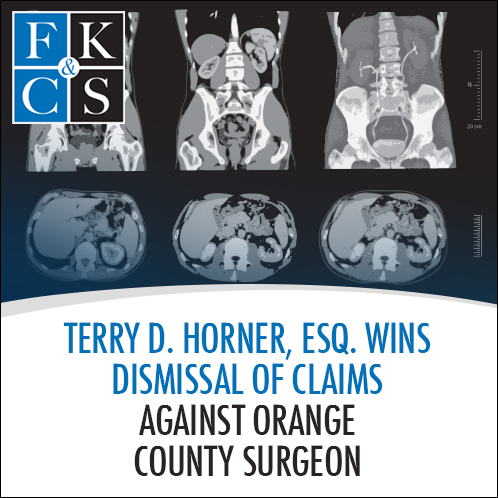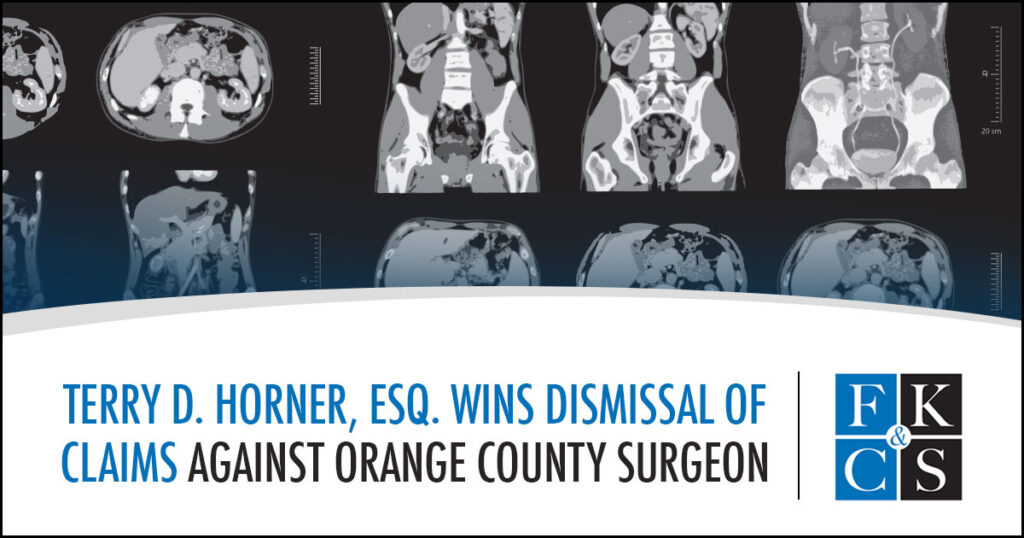 Terry D. Horner recently won a dismissal for an Orange County, NY surgeon in a case involving a then 66-year-old woman with a complex medical history of bilateral breast cancer for which she was being observed by an oncologist. The patient initially consulted a nurse practitioner (NP) with complaints of right lower quadrant pain. A computerized tomography (CT) scan of the chest/abdomen was ordered, and she was encouraged to follow up with her gynecologist (GYN), which she did not do. The CT of the abdomen/ pelvis (without contrast) revealed a diffusely enlarged uterus with calcifications consistent with fibroids. There were no adnexal masses or abnormal adenopathy, no ascites, no suspicious bony lesions, kidney stones, hydronephrosis, diverticula or gallstones. The gallbladder wall had normal thickness.
Terry D. Horner recently won a dismissal for an Orange County, NY surgeon in a case involving a then 66-year-old woman with a complex medical history of bilateral breast cancer for which she was being observed by an oncologist. The patient initially consulted a nurse practitioner (NP) with complaints of right lower quadrant pain. A computerized tomography (CT) scan of the chest/abdomen was ordered, and she was encouraged to follow up with her gynecologist (GYN), which she did not do. The CT of the abdomen/ pelvis (without contrast) revealed a diffusely enlarged uterus with calcifications consistent with fibroids. There were no adnexal masses or abnormal adenopathy, no ascites, no suspicious bony lesions, kidney stones, hydronephrosis, diverticula or gallstones. The gallbladder wall had normal thickness.
A month later the plaintiff presented to an Orange County hospital with complaints of right lower quadrant pain that was present for a few weeks. After a workup, it was believed to be more gynecologically related than appendicitis. She was admitted to the hospital by a hospitalist and seen by an OB-GYN who recommended a dilatation and curettage (D&C)/hysteroscopy, but the patient was too anemic at the time. It was believed that uterine fibroids and an ovarian cyst were causing her pain.
Another CT of the abdomen was performed, with the report indicating that the appendix was “not definitely visualized.” The plaintiff was seen by another hospitalist during this admission. He noted concern for possible perforated appendicitis, but there was no elevated white blood cell (WBC) count, no fever or chills and the clinical picture did not point to definite perforated appendicitis. The plaintiff was also seen by a different surgeon, who noted that the etiology appeared gynecologic in nature and did not appear to represent perforated appendicitis. A magnetic resonance imaging (MRI) of the pelvis and biopsy of the right lower quadrant lesion were recommended. Ultimately, the plaintiff was discharged by the admitting hospitalist.
About two weeks later, another MRI identified acute appendicitis with appendiceal abscess. One of the plaintiff’s oncologists referred her to Feldman, Kleidman, Collins & Sappe LLP’s (FKC&S) client, with whom she had a telehealth visit the next day (her very first contact with FKC&S’s client), in connection with right lower quadrant pain and an intraabdominal abscess. FKC&S’s client’s differential diagnoses of her pain included appendicitis and non-appendiceal origins. The plaintiff was seen multiple times by other physicians as an outpatient, with recommendations for interventional radiology (IR) drainage. Ultimately, she was scheduled to have the drainage, but did not go because she was in pain. Instead, she contacted her oncologist, who recommended that she go to the emergency room (ER); she did not.
Days later, the plaintiff had another telehealth appointment with FKC&S’s client; they again discussed the management strategies of the abscess in great detail, and he again recommended drainage, as had other physicians. FKC&S’s client also recommended that the plaintiff go to the emergency department (ED). She saw one of her oncologists that day as well, who also advised her to go to the ED.
The plaintiff was ultimately admitted to the hospital from the ED, where she remained for three weeks. An IR drain was placed to address the abscess. A few days later, FKC&S’s client operated: He performed an exploratory laparotomy, right hemicolectomy, drainage of abscess, wound exploration and debridement of the mons pubis and repair of umbilical hernia. The pre-and postoperative diagnoses were possible perforated appendicitis with abscess. An appendectomy was considered but the base and the cecum felt indurated and there was a question of a mass within the cecum, so the decision was made to do a right colectomy. The procedure was tolerated well. Her hospital course was complicated by progressive anemia and a myocardial infarction (MI).
The plaintiff did not oppose FKC&S’s motion for summary judgment (a request for dismissal without a trial) or those of the co-defendants, which the court accordingly granted, dismissing the complaint. FKC&S’s client was spared the aggravation of a trial and the lost time of being in court and not being able to treat his patients.

